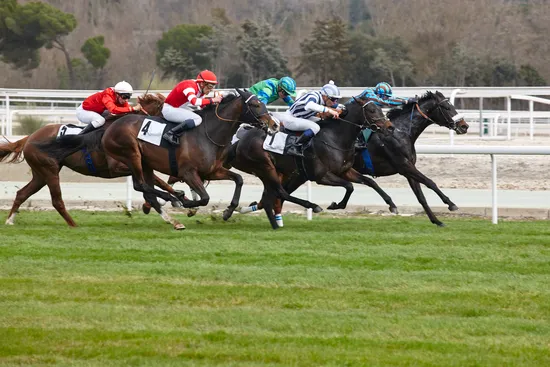Track surfaces are pivotal in sports betting, particularly in horse racing, as they significantly influence the overall performance of horses and equine athletes. For horse bettors, understanding the different track surfaces is vital for making more informed wagering decisions.
With a deeper knowledge of varying surfaces, punters can better assess horses’ performances and predict race outcomes more accurately. This allows bettors to adjust their strategies and optimize their chances of success in Singapore Pools sports betting.

Track Surfaces Explained
Dirt
Dirt is the most traditional and commonly used track surface, having been a staple of Singapore Pools horse racing for years. Dirt tracks are usually made of clay, sand, and soil and are relatively inexpensive to maintain. While they offer good traction for horses, they can become inconsistent because of weather changes, increasing injury risks. Dirt track surfaces also tend to be more beneficial for horses with early speed, which can potentially make an imbalanced playing field.
Turf
Turf tracks provide a unique racing experience than dirt tracks. For instance, horses can prevent more slides and slips, contributing to their overall health after races. These tracks also do not have clods or dust, which may sometimes hinder the horse or jockey in races. However, turf tracks typically necessitate more maintenance. Furthermore, unlike other tracks, weather conditions significantly influence turf surfaces the most.
Synthetic
Synthetic racetrack surfaces are a modern inclusion in horse racing. These usually consist of sand, wax, rubber, and fibres. Artificial tracks may offer a uniform, all-weather surface that is more predictable than dirt or turf. This makes them unaffected by weather conditions and superior damage, ultimately ensuring safety. Yet, synthetic tracks can also pose challenges, such as installation and higher maintenance costs. Horses may also not perform as well on artificial tracks compared to dirt or turf.
Betting Tips for Various Horse Track Surfaces
Incorporating tips for horse track surfaces can help punters maximise their horse betting in Singapore success. These insights guide punters in effectively navigating the intricacies of each surface. Below are some betting tips for the different racetrack surfaces:
Betting on Dirt Tracks
- Understanding track conditions in dirt tracks is vital for horse racing success. The track’s surface condition can significantly affect race outcomes, so evaluating them enables bettors to make more informed decisions. For instance, fast tracks are dry racetracks that allow horses to achieve peak performance, resulting in their fastest times. Wet-fast tracks have more moisture but remain firm enough to produce swiftness.
- Punters should consider conducting a thorough analysis of speed figures and pace handicaps for effective wagering on dirt tracks. Comprehending these metrics can provide valuable insights into race dynamics, which are crucial for analysing trends and patterns to refine future betting strategies.
- Some racetracks demonstrate a bias towards a specific running style or starting position due to soil composition or track configuration. In certain cases, this prejudice makes it unreasonable to bet on horses not favoured by it.
Betting on Turf Tracks
- The jockey plays a pivotal role in track races. Unlike dirt track races, where speed dominates, turf race requires strategic ground-saving and timely sprinting. Jockeys can conserve their horse’s energy and organize precise timing, guiding them to unleash their speed at the optimal moment. Knowledge of the jockey’s skills and past performances helps gamblers assess a horse’s likelihood of success.
- Turf track conditions are also a significant factor when betting. For example, certain horses perform better on turf surfaces that are slightly moist but firm, as opposed to soft, wet courses. Understanding how horses perform on turf can be beneficial for bettors in enhancing their strategies.
- Bettors should also examine a horse’s strength. Since turf races usually have longer races than dirt tracks, endurance is essential for horses. Assessing their performance in past longer-distance races can reveal their stamina and fatigue levels. Experienced horses on long turf tracks, trained by reputable trainers, demonstrate strong endurance potential.
Betting on Synthetic Tracks
- Synthetic tracks offer more durability in various weather conditions than dirt or turf. Still, it is vital to monitor weather forecasts. By observing weather predictions, gamblers can understand how changing climate may impact track conditions and adapt their strategies accordingly.
- Evaluating a horse’s past results on artificial surfaces aids in identifying those who excel at navigating this surface. Look for horses who have a history of success on synthetic tracks to determine their potential to perform well in future races.
Elevate Your Horse Betting with Tailored Track Surface Strategies
Understanding the nuances of horse track surfaces on racehorse performance involves physical, environmental, and horse-specific considerations. Assessing factors like track bias and performance history of horses and jockeys can better inform Singapore casino gambling decisions, ultimately enhancing horse betting success.
If you are looking for a reputable horse betting platform, CM2Bet offers the best betting odds and opportunities in various horse racing markets. Register on our website www.cm2bet.com/ and start wagering today!
Read More: The Positive and Negative Aspects of Engaging in Exotic Horse Bets





 HOTLINE:
HOTLINE: 















